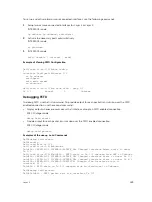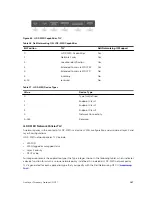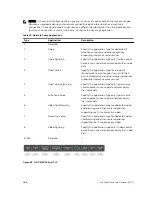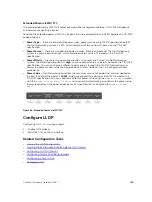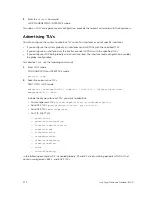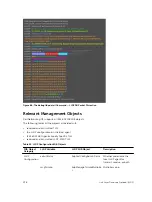
Figure 62. LLDP-MED Capabilities TLV
Table 26. Dell Networking OS LLDP-MED Capabilities
Bit Position
TLV
Dell Networking OS Support
0
LLDP-MED Capabilities
Yes
1
Network Policy
Yes
2
Location Identification
Yes
3
Extended Power via MDI-PSE
Yes
4
Extended Power via MDI-PD
No
5
Inventory
No
6–15
reserved
No
Table 27. LLDP-MED Device Types
Value
Device Type
0
Type Not Defined
1
Endpoint Class 1
2
Endpoint Class 2
3
Endpoint Class 3
4
Network Connectivity
5–255
Reserved
LLDP-MED Network Policies TLV
A network policy in the context of LLDP-MED is a device’s VLAN configuration and associated Layer 2 and
Layer 3 configurations.
LLDP-MED network policies TLV include:
• VLAN ID
• VLAN tagged or untagged status
• Layer 2 priority
• DSCP value
An integer represents the application type (the Type integer shown in the following table), which indicates
a device function for which a unique network policy is defined. An individual LLDP-MED network policy
TLV is generated for each application type that you specify with the Dell Networking OS CLI (
).
Link Layer Discovery Protocol (LLDP)
467
Summary of Contents for Z9000
Page 1: ...Dell Configuration Guide for the Z9000 System 9 7 0 0 ...
Page 80: ...grub reboot 80 Management ...
Page 128: ... 0 Te 1 1 Te 1 2 rx Flow N A N A 128 Access Control Lists ACLs ...
Page 491: ...Figure 70 Configuring OSPF and BGP for MSDP Multicast Source Discovery Protocol MSDP 491 ...
Page 496: ...Figure 73 MSDP Default Peer Scenario 1 496 Multicast Source Discovery Protocol MSDP ...
Page 497: ...Figure 74 MSDP Default Peer Scenario 2 Multicast Source Discovery Protocol MSDP 497 ...
Page 498: ...Figure 75 MSDP Default Peer Scenario 3 498 Multicast Source Discovery Protocol MSDP ...
Page 760: ...Figure 100 Single and Double Tag TPID Match 760 Service Provider Bridging ...
Page 761: ...Figure 101 Single and Double Tag First byte TPID Match Service Provider Bridging 761 ...







